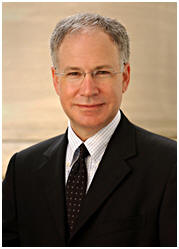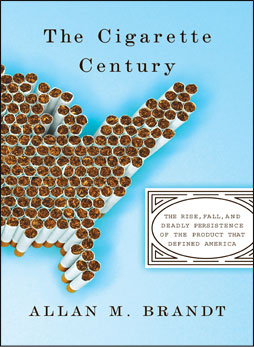Palestra e depoimento de Allan Brandt
Um dos maiores conhecedores da epidemia do tabagismo e um dos maiores críticos das ações nefastas da indústria do tabaco

Chefe do Departamento de História da Medicina e membro do Departamento de História da Ciência da Harvard Medical School

Em 2007, Allan Brandt, para transmitir parte do que conhecia sobre o assunto, lançou o livro:
Na Cody's Book, um uma livraria em Berkley, Califórnia, na fase de divulgação de 'O Século do Cigarro', Allan Brandt deu palestra sobre dois aspectos abordados no livro:
1 - A manipulação da opinião pública e da classe médica pela indústria do tabaco na metade do século XX.
Transcrição da palestra
The second question in the book is ‘how do we know that smoking is dangerous?’
It seems almost a crazy question to ask, in 2007, but in the middle of the 20th century as rates of lung cancer rose, cigarette smoking was one of several hipothesis about what was causing this dramatic change in patterns of this disease and some of the epidemiologists, the early epidemiologists who work on the problem said 'I was betting it would be cars'. If you look at the graphic for cars, it looks very similar in many ways to the rise in cigarette smoking. One of the epidemiologists said 'paved roads and asphalt which put that a lot of toxins into the environment'. It was car and paving roads, not cigarettes.
And even if there was a lot of concern about smoking and health, the strategies, the scientific strategies for running that to ground are in my mind one of the great accomplishments of mid 20th century medicine and science, involve a really creative thinking. It was around the time when people were starting to run those clinical trials, and they realized that we couldn’t divide up a group of kids, half of whom you’d say “you’ll become smokers” and half of whom you would say “you cannot be a smoker” and follow them forward the way we would if we were randomizing a trial. So, Doll and Hill in Great Britain, and a surgeon in St. Louis, Everest Grand, and one of his medical students, France Winder, started to do the studies with the tracing people forward that carefully match: smokers to non smokers, and then see what happen with their health. And it’s really the basis today for what we would call evidence based medicine.
So, again, I find in these stories are the structure of the basic, to the history of the United States throughout the 20th century. And, by 1954-1955, the evidence that smoking causes lung cancer was very, very significant, if not overwhelming. So. what did the companies do? They sponsored ads which say ‘more doctors smoke Camels than any other brand!”. They had ads which say ‘Play safe, smoke Lucky Strikes!’. They had ads that said, you know, “Just what the doctor ordered, L&M’s new miracle filter’. And it was very brilliant, and they said ‘you know, that is not proved’. The sponsored science scientifically erected attention away from the cigarette. And so, I also find in this History, the urgence of our scientific desinformation campaigns and the ways of manipulating science. In many ways, the industry developed the most significant attack on the normal workings of science, I think we had probably seen in the 20th century. How can we disrupt the science? That was the question. On the one hand, they were telling the public “there is no proof”, but we have filters”. On the other hand, I’ve found many documents about what the industry knew, and when it knewed, and it is what I have testified in the trial of down. I found one document of R. J. Reynolds, 1953, and it ‘s by a scientist, named Claude Thie, and he says “we’ve been experimenting with the pH of filters, and it turns out by varying the pH, we can make filters turn to any color, and he said “We’ve found with focused groups that if we made filters turn to yellow or brown, people are convinced that they are more effective. Unfortunately, we have no way of removing the non carcinogens, but we believe this discovery of pH in filters will be an important marketing tool”. 1953. So, admirably there are hundreds and hundreds of incriminating documents from the industry, laboratories and scientists, during the same period that they were writing to doctors saying “make up your own mind, this is really a clinical issue, some patients perhaps should be told to switch to our brand, but they want to maintain smoking within the domain of individual clinical judgement as opposite to the categorical finding that smoking causes lung cancer. And it eventuates in the first surgeon general’s report, which in my own I would never be reading except for the desinformation campaing the industry was waging. We find people in public health saying “if we don’t pool independent scientists together and have them make a definitive statement this controversy will go on and on. So the second section of the book is this question: ‘how do we know?’ and we really document this process for knowing ...
2 - A dificuldade das pessoas em abandonar a nicotina, devido à forma como o cigarro foi construído e reconstruído, e como a indústria aplicou ações de marketing fortes, exatamente para aprisioná-las.
Em breve escreveremos a transcrição desta palestra.
O maior processo judicial da história americana, que iniciou em 2004, foi o movido pelo Departamento de Justiça dos Estados Unidos (DOJUS) contra a indústria do tabaco.
A promotoria americana convidou autoridades importantes, dos mais diversos ramos de atividades e do conhecimento, para esclarecimentos sobre todo o processo de desenvolvimento do produto responsável pela maior epidemia mundial de mortes evitáveis que se tem notícia, a causada pelo tabagismo.
Entre estas autoridades, Allan Brandt foi um dos convidados, em virtude de sua sólida formação em História da Medicina; sua posição como Chefe do Departamento de História da Medicina da Universidade de Harvard; seu conhecimento como membro do Departamento de História da Ciência da mesma Universidade; e, sua notória expertise em tabacologia.
As principais indústrias do fumo do mundo são americanas ou angloamericanas. Nos EUA, morrem atualmente 1.200 pessoas por dia por doenças relacionadas ao tabaco, gerando igualmente imenso custo financeiro para o país.
O depoimento abaixo, portanto, é a contribuição por escrito de Allan Brandt ao processo. Uma denúncia de peso.
N.R. Estamos disponibilizando os depoimentos das outras autoridades_ link.

